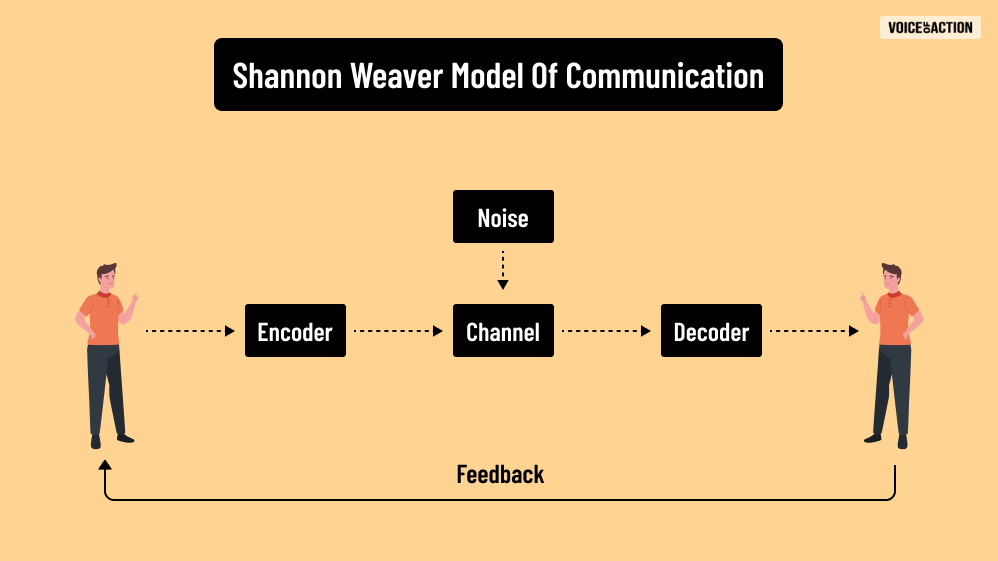The Basics of Shannon Weaver’s Model of Communication- Analysis and Examples

The roots of Shannon and weaver model of communication
Shannon Weaver’s model of communication was first time introduced in 1948. The theory is the basis of Claude Elwood Shannon’s paper presentation “A Mathematical Theory of Communication. In this paper, Shannon explained his goal for the model, by saying.
The fundamental problem of communication is that of reproducing a message sent from one point, either exactly or approximately, to another point.
Shannon, 1948, p.379
After that, Norbert Wiener is adding 7 concept feedback which is changing the model from the liner to a cyclical model.
The Shannon theory’s main purpose is to explain how messages get lost and distorted in communications. Now let’s start with the definition of the Shannon Weaver model.
What Is Shannon Weaver Model?
The Shannon-Weaver model is the most influential model of communication. The senders encode the messages and then send them back to the receiver through the technology.
The functions of these models are more like the telephone and telegraphs. The senders convert the messages into codes that are understandable by the machines. These messages are sent in the format of the code through the mediums.
The Shannon Weaver model of communication is part of the communication basis mathematical theory. That argues with human communications. According to this communication model, human communications can be broken down into six key concepts, which are the sender, encoder, channel, noise, decoder, and, last, the receiver.
Functions Of The Shannon Weaver Model Of Communication Concepts
The communication process model has six different concepts. Read it and know.
Sender- The person who is going to send the messages through the channels.
Note: “The sender’s messages are converted into signals like waves or Binary data which is compatible with transmitting the message through cables or satellites. For example: In telephone, the voice is converted into wave signals, and it transmits through cables.”
Encoder- An encoder is a sender who uses machines to convert messages into signals and binary data.
Channel – Channels are the medium that is used to send messages.
Decoder- A decoder is a machine which is receiving signals and then convert them into binary messages.
Note: “The receiver converts those binary data or waves into the message which is comfortable and understandable for the receiver. Otherwise, the receiver can’t receive the exact message, and it will affect the effective communication between sender and receiver.”
Receiver- A receiver is a person who gets the decoded messages.
Note: “Based on the decoded message, the receiver gives their feedback to the sender, If the message is distracted by noise, it will affect the communication flow between sender and receiver.”
Noise: Noise is the physical disturbance which is working as a barrier to communication.
Note: “The model clearly deals with external noises only which affect the messages or signals from external sources, For example: If there is any problem occurring in the network which directly affect the mobile phone communication or distracts the message.”
Examples of The Shannon-Weaver Model Of Communication
“The Shannon-Weaver model of communication was originally proposed for technical communication, such as through telephone communications. Nonetheless, it has been widely used in multiple different areas of human communication.”
Here are a few examples of how the Shannon-Weaver model of communication works:
- A Telephone Conversation.
- Listening to the Radio.
- A face-to-face discussion.
A Telephone Conversation.
The person who makes the phone call is the sender here. Let’s imagine a shannon weaver model example situation here. Let’s imagine you make the phone call. If you are calling, you must have your genuine content. I mean you must have something important to convey to the other person. But there is a process that helps the other person hear what you are saying.
The phone converts your messages into some bit-sized data packets. These data packets can quickly go down the satellite path and reach the receiver’s trajectory. So, the phone acts as the encoder here.
The phone’s wires or its satellite act as the primary channel here. When the speaker is unclear, that’s noise for you.
The other two shannon weaver model elements are the decoder and the receiver. The person at the other end is undoubtedly the receiver. But his phone acts as the decoder. When the phone decodes the data bits, the receiver hears them as normal human voices.
The conversation ends with feedback. But what’s the input in the phone call? When the receiver says something in reply, it’s understood that the original message is loud and clear. That is the feedback part here.
Listening to the Radio.
The radio host (sender) speaks into the microphone and shares the original message. Then comes the encoder. First, the mic and then the computer turn the voice into binary data pockets. After that, the data pockets trail to the transmitter. It is the last part of the encoder. It transforms the data into radio frequency waves.
The radio waves are the channel here. The transmitter sends out the waves to the receiver’s transistor radio. If the receiver does not tube to the right frequency, he’ll listen to noises or interruptions.
Now, it’s time to decode the message. And the receiver will depend on his transistor device to do the same. It will transform the radio voices into voice mode. But there’s a catch. In this mode, feedback sharing is quite challenging. But radio channels often communicate with listeners. You can share your feedback then.
A face-to-face discussion.
Let’s check out another shannon weaver model example. Firstly, one person will speak out. And initiate the conversation. He is the sender here. After that comes the encoder. However, the encoder is generally a machine. But that is unavailable here. So, the sender’s intellectual words and sentence framing will act like the encoder here.
The channel here is the voice box that sends the sound to the other person. Generally, there is no noise here. But a distorted accent or speech disabilities of the sender may also act as occasional noises here. Now comes the receiver since there is no separate decoder here. He hears the message and says something in return (feedback).
Explanation Of Shannon Weaver’s Model Of Communication
The sender sends the messages through the Shannon Weaver model. Shannon was an Engineer. This model was first developed to improve technical communication, such as telephonic communications. It was developed to improve the telephone capacity.
Now let’s move on to Weaver’s transmission model of communication examples. After the weaver definition, the samples will give you a better idea about this model’s basic functions.
Any of the business communications which is flowing through from the businessman to their subordinates comes under this communication model. When the businessman is instructing something over the phone, then here are the illustrations of the Weaver model.
- The sender is a Businessman.
- The encoder is a telephone network company.
- Channel is a mobile network.
- Noises are the missing text due to disruption.
- The decoder is a mobile phone.
- Receivers are the workers.
Advantages & Disadvantages Of Using The Shannon Weaver Model
The Shannon-Weaver Model is the basic model of communication for telecommunications. For telecommunication, models count all the noises and potential communication problems that are working as barriers to communication.
Here are the two advantages of using the Shannon-Weaver model communication.
- “It explains the barriers to effective communication very well.” They are,
- Technical Problems
- Semantic Problems
- Effectiveness Problems
- “It breaks down communication into understandable parts.”
- Transferable to multiple situations.
Here are the two disadvantages of using the Shannon-Weaver model of communication.
- “It’s a Linear model. So, there is no chance of feedback sharing.
- You cannot use this model in communication taking place in a power relationship
- You cannot address queries and concerns using this communication model
Challenges of the model
When planning communication, you might face some challenges. The biggest challenge is that this model has no scope for recipient feedback.
Shannon Weaver’s model is about sending the message to the recipients only. It does not consider how the receiver will react to what they might want to say.
So, using the model for complex communications like project planning meetings is difficult. In such meetings, there will be multiple feedback loops. Similarly, there will be lots of dialogue.
Secondly, you cannot convey complex feelings or emotions through the model. You can’t know if the listener trusts or believes in your message without feedback. Hence, using the model to send an empathetic message is impossible.
Thirdly, the model says that the sender and the receiver are always on the same page. But that is not always possible.
Lastly, you cannot use this model to connect with people in this age of electronic media. Nowadays, people connect on social media. There are dedicated slots for comments. However, this model does not expect replies from the recipient at all.
What Are The Common Levels of Communication Problems?
The Shannon Weaver models of communication are commonly dealing with the three levels of communication problems. According to the communication process problems, these problems are
Semantic Error: Semantic error is the meaning of messages sent but received in a very different way.
Technical Error: Technical errors are a type of error that causes problems.
Effectiveness Error: How effective are your questions going to be? That means how effectively the message causes reactions.
Is Shannon Weaver’s Model Entirely Accurate?
Like every other basic model, the Shannon Weaver model also has some limitations.
Here are the limitations of Weaver’s models. Read it and know.
- It can be applied more to interpersonal communications. But for group communication, this is almost inapplicable.
- Receivers play the passive part in communications, and senders play the primary role in sending messages.
- Feedbacks are not so important part of the Shannon Weaver model.
- The model is sometimes misleading human communications as human communications are not part of mathematical communications.
The Shannon-Weaver model is a linear model of communications which is providing the framework for analyzing how messages should be sent and received. The model ensures that in the middle of the process, there is no misplacing of messages takes place.
How does Shannon Weaver’s Model help in Communication Planning?
During communication planning, you can use the model in multiple areas. But you need to use it creatively. First, underline all factors that impact your communication. After that, consider the scenario or specific situation when you can use the model.
Plan everything. Decide who will be the sender and receiver during communication. Also, plan what channel you would like to use. Finally, the noise or distractors that can damage the communication pathway should be considered.
Once you identify these factors, you can easily use the model to communicate messages and send information across your organization.
Frequently Asked Questions (FAQs):
Now you know what is the basic functions of the Shannon-Weaver model. Let’s see what other queries often the viewers are having related to the communications models.
Ans: The Shannon and Weaver model of communication is the most famous among all communication models. It defines as the most important component of any communication process. So if you like to understand the communication model in a more interactive way, you have to use it.
Ans: Transactional communication is the most effective communication model. Transactional communication can be both verbal and nonverbal. Transactional communication is a model which analyses the causes of delayed messages.
Ans: Ans: The Shannon and Weaver communication models help in clear communication between the sender and receiver. A design is like a roadmap with a sender, a receiver, and a channel.
Wrapping It Up:
The Shannon Weaver model is the oldest traditional communication interpreting model. I think the points related to the Weaver models are clear to you. If you are thinking we are missing out on any of the points related to the Weaver models or any other communication models. Then you can use the comments sections to share your opinion.
Read More:


























